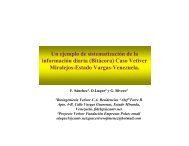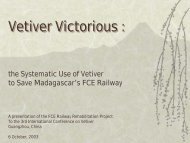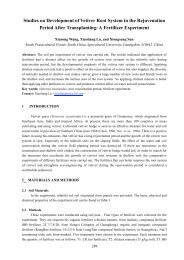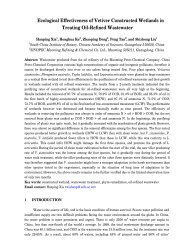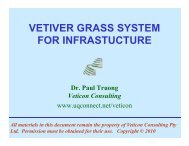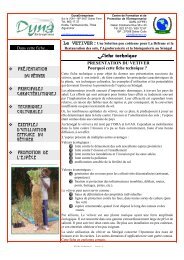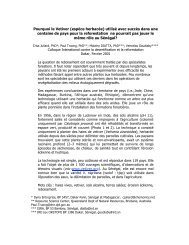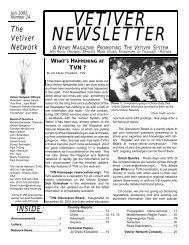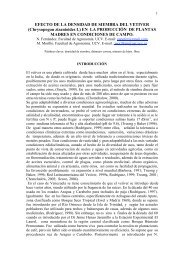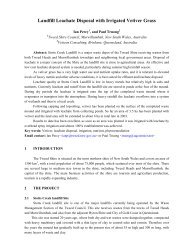Read more
Read more
Read more
- No tags were found...
Create successful ePaper yourself
Turn your PDF publications into a flip-book with our unique Google optimized e-Paper software.
IntroductionWomenWeave had organised a workshop which aimed at using the handloom waste produced at the Gudi Mudi centeras well as the waste produced by other weavers across Maheshwar town. We collected all the waste from Gudi Mudiand a few other master weavers in town. We categoried the waste into four main categories.The motive of the workshop was to come up with innovative ways of using the waste to make textile based products.To help us do so, we had with us an American designer named Docey Lewis who has worked with artisans all acrossthe world and is associated with the organisation ‘Aid to Artisans’. Her area of work ranges from textiles and accessoriesfor fashion to home furnishings, wallpapers, basketry, toys and many <strong>more</strong>.The workshop started with Docey reacting to the categorised waste and sorting them into bunches as per colour. Wethen went on to material preparations for various kinds of wefts. Docey also introduced us to new techniques ofbraiding, looping and tapestry weave. We learnt ways of finishing the selvedge neatly as well as making shuttles to suitour purpose of weaving thicker yarns and fabric strips.As a part of preparation before the workshop we had tried a few settings of the warp and woven a few samples to giveDocey an idea of the weight of the fabric, textures etc. These fabrics were also converted into finished products (bags)by Docey during this workshop.Following is a report with images and details of each stage of the workshop, the final outcome and the concepts /ideastaken into production.
The workshop teamThe team consisted of ladies who work at the Gudi Mudi center. Three of them were C grade weavers, two worked onfinishing and one on spinning/bobbin winding and one on sewing the products. The idea of the workshop was also todevelop a range which can be woven by the C grade (low skilled) weavers.
Sorted waste in four main categories:Yarns- in the form of hanks and warp ballsNon organic fabric wasteBagh printed non organic fabric- in the form of smalllengths and garment wasteMaheshwari fabric- Cotton silk mixtures and a few puresilk pieces
Initial sortingDocey started with the sorting of yarns in various colour combinations and then went onto combining various printedand non printed fabrics together with yarns. Bunches of such combinations were prepared before moving onto materialpreparations for weaving.
Combinations and ideas with existing woven pieces
Material PreparationsThe waste hanks were separated into strands of a particular thickness and knotted together to make bundles of yarnwhich were then wound onto vetiver bunches in various ways before being inserted as weft.
Initial trials
Training the women in material preparationThe ladies were trained in bunching up vetiver and wrapping them with bundles of yarns as well as fabric strips. Thiswas prepared to be woven as weft for table runners.
Braiding techniquesDocey taught various ways of braiding - 8 strand square, 6 strand flat, four strand flat and round, 4 ply twisted twovariations, 2 ply twistedThe ones which can be taken into production immediately are- 4 strand round braid and 2 ply twistedOnes to be practiced- 6 strand flat braid ‘kajuri chhoti’Videos of each are taken and will be sent out in a data disc for reference in future.
Fabric strips to be wovenCutting on the biasCutting along the weft to get a continuous strip all along
The fabric strips are then joined together by running a stitch on the sewing machine twice. They are then cut andseparated to get a continuous long strip of fabric which is wrapped onto plastic shuttles.
Shuttle SpecificationsPlastic shuttles prepared at the workshop to aid weaving of thicker yarns and fabric strips in the weft. The yarn/fabricstrips have to be wound around the shuttle to make a figure of eight. This helps winding <strong>more</strong> lengths of yarn/fabricstrips onto the shuttle at one go.Ski shuttles used for rug making can be an option in the future for easier and faster weaving as suggested by Docey
Introducing new weaving techniquesThe Scandinavian looping technique was taught by Docey to our weaversA technique which is relatively easy but gives a look of tapestry/inlay (it looks like weaving where two or three shuttlesare used along one weft line- similar to temple borders in sarees)
Process from weaving to finished products by Gudi Mudi participants
Final bags to be taken into productionAll these patterns involve minimal cutting and no wastage. Darts and pleats are used to create the various shapes andgive the bag volume. Selvedge is used at most places to hold the seams so as to avoid overlocking or hemming or frenchseams. Incase of the small ‘batuas’ or handbags, 3 seams are taken along the warp ends to stop the edges from frayingand locking them (along the end which has to be cut).
Concepts/ ideas to be explored in future1. Patchwork of our wovens, printed and Maheshwari fabrics with running stitch2. Various bag shapes and sizes



